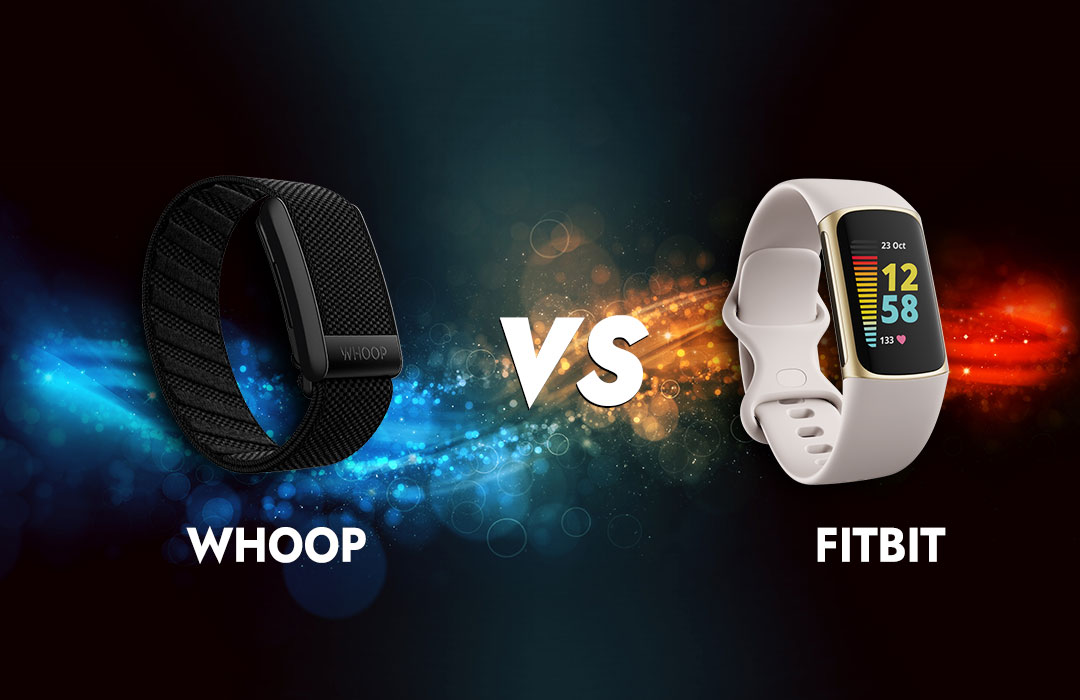When it comes to fitness trackers, two of the most popular options on the market are Whoop and Fitbit. These wearable devices have revolutionized the way we monitor and track our fitness goals. But with so many options available, choosing the perfect fitness tracker for your lifestyle can be overwhelming. In this article, we will compare Whoop and Fitbit to help you make an informed decision. Whether you’re an athlete, a fitness enthusiast, or someone looking to improve their overall health, we’ve got you covered. Let’s dive in and explore the features, functionalities, and benefits of both Whoop and Fitbit.
Whoop vs Fitbit: An In-depth Comparison
Whoop: The Ultimate Performance Tracker
Whoop is a fitness tracker designed specifically for athletes and individuals serious about optimizing their performance. Its primary focus is providing detailed insights into your body’s physiological data. From heart rate variability (HRV) to sleep quality and recovery, Whoop tracks it all. It comprehensively analyzes your body’s readiness to perform, helping you make informed decisions about your training and recovery.
Whoop’s standout feature is its ability to provide personalized recommendations based on your data. Analyzing your sleep, strain, and recovery patterns offers actionable insights to help you train smarter and prevent overexertion. Whoop also boasts a vital community aspect, allowing users to compare their data and engage in friendly competition.
Fitbit: The All-in-One Fitness Companion
Fitbit, on the other hand, is a well-rounded fitness tracker that caters to a broader audience. It offers many features, including activity tracking, heart rate monitoring, sleep tracking, and even smartwatch capabilities. Fitbit’s user-friendly interface and intuitive app make it accessible to beginners and fitness enthusiasts.
One of Fitbit’s strengths lies in its extensive ecosystem and compatibility with various fitness apps and devices. Whether you want to track your daily steps, monitor your heart rate during workouts, or receive smartphone notifications on your wrist, Fitbit has you covered. With its sleek design and customizable bands, Fitbit also focuses on fashion and style, making it a popular choice for everyday wear.
Head-to-Head Comparison: Key Features
Let’s compare the key features of Whoop and Fitbit to help you decide which fitness tracker suits your lifestyle:
| Feature | Whoop | Fitbit |
|---|---|---|
| Sleep Tracking | ✔ Detailed sleep analysis | ✔ Sleep stages & sleep score |
| Heart Rate | ✔ Continuous heart rate monitor | ✔ 24/7 heart rate tracking |
| Activity | ✔ Automatic activity detection | ✔ Multi-sport tracking |
| Battery Life | ✔ Up to 5 days | ✔ Up to 7 days |
| Waterproof | ✔ Water-resistant | ✔ Swim-proof |
| App Ecosystem | ✔ Limited integrations | ✔ Wide range of app compatibility |
Whoop vs Fitbit: Which One Is Right for You?
Now that we’ve examined the key features of Whoop and Fitbit, it’s time to determine which fitness tracker is the perfect fit for your lifestyle. To help you make a decision, consider the following factors:
Fitness Goals: Are you an athlete or someone focused on performance optimization? If so, Whoop’s detailed physiological data and personalized recommendations may be ideal. On the other hand, if you’re looking for an all-in-one fitness companion with a broader range of features, Fitbit might be more suitable.
Data Analysis: Do you prefer an in-depth analysis of your body’s metrics and trends? Whoop provides extensive insights into sleep, recovery, and strain. Conversely, Fitbit offers a more holistic approach with its comprehensive activity tracking, heart rate monitoring, and sleep analysis.
Community and Social Interaction: Are you motivated by competition and community engagement? Whoop’s vital community aspect allows you to connect with other users, compare data, and challenge each other. Fitbit also offers social features, focusing more on individual progress and achievements.
Remember, the perfect fitness tracker is the one that aligns with your goals, lifestyle, and preferences. Both Whoop and Fitbit offer exceptional features and functionalities; it’s all about finding the right fit for you.
Activity Tracking
Winner: Fitbit
Fitbit takes the lead in activity tracking with its comprehensive features. It offers automatic activity detection and multi-sport tracking, allowing you to monitor your workouts and physical activities accurately. Whether running, cycling, or practicing yoga, Fitbit provides detailed insights into your exercise sessions.
Health and Sleep Tracking
Winner: Whoop
When it comes to health and sleep tracking, Whoop shines. It goes beyond basic sleep tracking and provides a detailed analysis of your sleep patterns, recovery, and overall well-being. Whoop’s emphasis on physiological data and personalized recommendations sets it apart in this category.
Ease of Setup
Winner: Fitbit
Fitbit takes the crown for ease of setup. With its user-friendly interface and intuitive app, setting up your Fitbit device is a breeze. The guided setup process ensures a seamless experience, allowing you to track your fitness goals quickly.
Ease of Use
Winner: Fitbit
Fitbit’s user-friendly interface and intuitive navigation make it the winner in ease of use. Its simple design allows users of all levels to easily navigate the device and app, making fitness tracking effortless.
Design and Comfort
Winner: Fitbit
Fitbit’s sleek and stylish design and its wide range of customizable bands make it the winner in design and comfort. Fitbit offers a variety of options to suit your style, ensuring that you can wear your fitness tracker with both comfort and fashion.
Compatibility
Winner: Whoop
Whoop takes the lead in compatibility. While Fitbit offers a wide range of app integrations, Whoop focuses on providing a seamless experience within its ecosystem. Whoop integrates with other fitness apps and devices, allowing you to sync and analyze your data in one place.
Battery Life
Winner: Fitbit
Fitbit outperforms Whoop in terms of battery life. Fitbit devices typically have a longer battery life, lasting up to 7 days on a single charge. This is beneficial for those who prefer not to worry about frequent charging.
Water Resistance
Winner: Fitbit
Fitbit claims victory in water resistance. Fitbit offers swim-proof models, allowing you to wear your device while swimming or engaging in water-based activities without concerns.
Membership Subscription
Winner: Fitbit
Fitbit wins in the membership subscription category. While Whoop requires a monthly subscription for access to advanced features, Fitbit provides a range of features and functionalities without a subscription.
Device Cost
Winner: Fitbit
Fitbit takes the crown for device cost. Fitbit offers a variety of options at different price points, making it more affordable for individuals seeking a fitness tracker without breaking the bank.
GPS
Winner: Fitbit
Fitbit emerges as the winner in terms of GPS functionality. Fitbit devices with built-in GPS allow you to accurately track your outdoor activities and view detailed maps of your routes.
Extra Features
Winner: Whoop
Whoop takes the lead in terms of extra features. While Fitbit offers a wide range of features, Whoop’s focus on performance optimization and its ability to provide personalized recommendations make it stand out in this category.
In conclusion, Whoop and Fitbit have their strengths and cater to different needs. Fitbit excels in activity tracking, ease of setup, ease of use, design and comfort, battery life, water resistance, membership subscription, device cost, and GPS
Frequently Asked Questions (FAQs)
Whoop and Fitbit excel in sleep tracking but approach it differently. Whoop provides detailed sleep analysis, focusing on metrics like REM sleep, deep sleep, and sleep efficiency. Conversely, Fitbit offers sleep stages and a score to give you a comprehensive overview of your sleep quality. Ultimately, the choice dep
Yes, both Whoop and Fitbit are water-resistant. Whoop is designed to be water-resistant, making it suitable for swimming and water-based activities. Conversely, Fitbit offers swim-proof models, ensuring that you can wear it while swimming without any concerns.
Regarding battery life, Fitbit has a slight edge over Whoop. Fitbit trackers typically last up to 7 days on a single charge, while Whoop’s battery life ranges from 3 to 5 days. However, it’s important to note that battery life can vary depending on usage and the features enabled.
Fitbit has a wide range of app compatibility and can sync with popular fitness apps like MyFitnessPal, Strava, and Runkeeper. Whoop, on the other hand, has limited integrations with third-party apps. If app ecosystem and integration are essential to you, Fitbit offers a more extensive selection.
Both Whoop and Fitbit allow you to monitor your heart rate during workouts. Whoop provides continuous heart rate monitoring, while Fitbit offers 24/7 tracking. Whether running, cycling, or engaging in any other physical activity, both fitness trackers will keep you informed about your heart rate zones.
Fitbit offers a wide range of customizable bands, allowing you to personalize your fitness tracker to match your style and preferences. On the other hand, Whoop has a more limited selection of bands but focuses more on functionality and performance than fashion.
Conclusion
Choosing the perfect fitness tracker for your lifestyle is a personal decision. Whoop and Fitbit offer unique features, functionalities, and designs that cater to different needs and preferences. Whoop’s detailed analysis and personalized recommendations make it an excellent choice if you’re an athlete or someone focused on performance optimization. On the other hand, Fitbit’s all-in-one fitness companion approach, extensive app ecosystem, and customizable design make it a versatile






